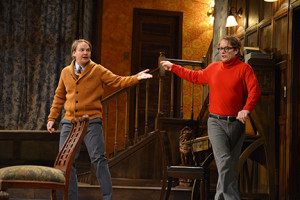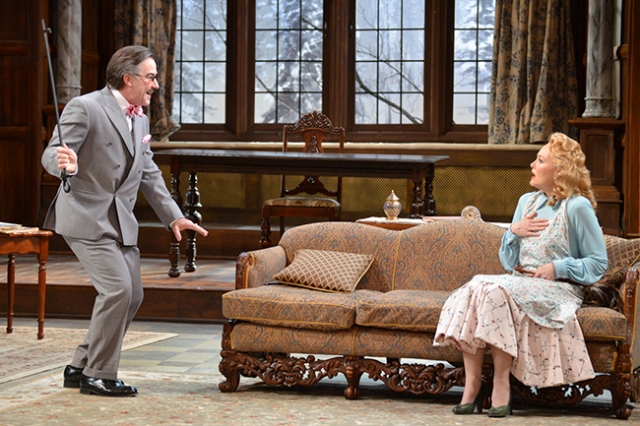Children are not aware of the dark and dangerous places from which many of their fairy tales and rhymes are taken. We learn as adults that “Ring Around the Rosie” was about the Black Plague and that “Hansel and Gretel” characters have been used to represent more evil as the story wound its way through time . Speaking of evil adding mystery and suspense, The Resident Ensemble Players (REP) use most effectively the tune of the children’s rhyme, “Three Blind Mice”, in their production of Agatha Christie’s THE MOUSETRAP. While the original 1850 folklore story ends well with the mice regaining both their eyesight and their tails, the “mice” who find themselves in the MOUSETRAP conceived by director, Steve Tague, meet quite a different fate.
MOUSETRAP has been playing in London’s West End at the St. Martin’s Theatre continually since 1952. Christie herself predicted only an eight month run. Christie, of course, is synonymous with the murder mystery genre; and MOUSETRAP is a gripping example of her story writing skill. Even with all of this history, it was amazing to find people in the audience who had never seen it and did not even know about it. But they are the same people who have provided full houses at St. Martin’s Theatre for all these decades. In addition, the London casts change regularly to bring new vitality to this assemblage of striking characters. The REP, under the astute guidance of Tague, has done the same. This production of MOUSETRAP will keep the audience talking all the way home and beyond.

Mic Matarrese as Giles and Jeffrey C. Hawkins as Christopher Wren in the REP’s production of THE MOUSETRAP. (Photo credit: N. Howatt)
As the story is usually set, there is an old English house, Monkswell Manor in fact, enduring a blizzard of rather epic proportions. English manor houses usually imply small, cramped rooms with an abundance of furniture and possessions indicating position and wealth. Tague and his scenic designer, C. David Russell, have instead created a chasm of a sitting room. The large picture window upstage is a focal point par excellence. Every item in the room is used throughout the play as characters stand at the fireplace, sit on the chairs, and fiddle with the radio. This might seem obvious, but it actually is not done often enough. This manor has been renovated to be a guest house, and the neophyte hosts are servicing their very first guests. The concentration of elements on this exquisitely painted and decorated room are carefully planned to maximize the beauty of “stage pictures” as the characters are welcomed, investigated, accused and murdered. Light and Sound designs by Matt Richards and Eileen Smitheimer, respectively, bolster the feelings of cold weather and changing times of day along with the crackling noises of early radio programming.
Tague has managed to create a slate of characters which are over-the-top but never so much that they become cartoonish. Mollie (Elizabeth Heflin) and Giles Ralston (Mic Matarrese) dash through the opening scene allowing the audience to love them as newlyweds on an adventure. Both Heflin and Matarrese evocatively portray their emotional changes as the unfolding events make them question their loyalty and love. First on the scene is Christopher Wren (NOT the architect), a boyish, seemingly erudite guest who gushes with women and shies away from the men. Portrayed with occasions of vulnerability and panache by Jeffrey C. Hawkins, Wren is someone immediately likeable; but as truths unravel, Hawkins gives his performance a tantalizing edge. The shrewish and haughty Mrs. Boyle, played with great impact by Kathleen Pirkl Tague, is equally understandable as a person of her time and detestable as her constant carping creates extra tension. Stephen Pelinski portrays Major Metcalf as the Doctor-Watson-esque character one almost expects to find in post-colonial England. Helpful but aloof is the Major. Deena Burke brings a level of theatrical prowess to her role of Miss Casewell. Needing to appear masculine in effect while being feminine requires physical commitment which Burke commands easily. That dichotomy alone keeps one guessing about her motivations and rationales. Next we have the introduction of the energetic, loquacious and opinionated Mr. Paravicini. Played with that level of foreign graciousness that is endearing, Lee Ernst gives a warm, sincere performance while still allowing the audience to question his motives. The final, and most unexpected, guest is Detective Sergeant Trotter, played with great fluidity of movement and vocality by Michael Gotch. He smoothly works his way around the room keeping some people at bay while systematically focusing everyone’s attention on his connections and his interpretations of events. Audiences now have come to expect a certain quality in their portrayed English police personnel and Gotch’s work is admirable with this early example of the type.
THE MOUSETRAP by The REP will be remembered not only for the early drawing room mystery characters the audience will encounter but also for the good work done by these solid characters to explore the Christie narrative to best advantage.
THE MOUSETRAP
Written by Agatha Christie
Directed by Steve Tague
January 23 – February 9, 2014
The Resident Ensemble Players
Roselle Center for the Arts
University of Delaware
110 Orchard Road
Newark, DE 19716
302-831-0358
www.rep.udel.edu


